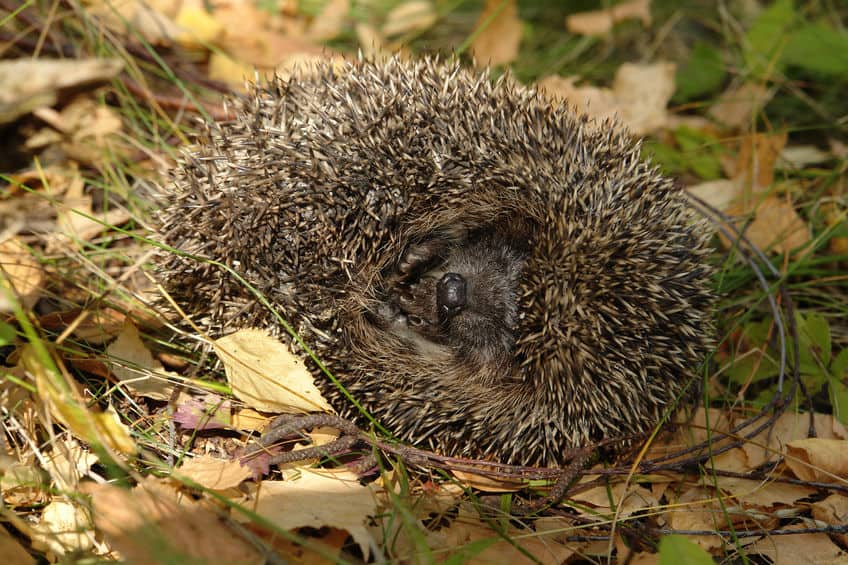An interesting thing about hedgehogs is that they can and do hibernate at certain times of the year. This guide will help you understand why they do this and what you can do to prevent it from happening if you own them as a pet in your home. It can also help decrease the chances that your hedgie’s health is affected if they do try to hibernate.
Do All Hedgehogs Hibernate?
Hibernation in Wild Hedgehogs
In the wild, a hedgehog is exposed to weather conditions that are out of its control. For this reason, they forage for food naturally and will eat lots of fatty foods including insects, and high-sugar foods including fallen fruits and berries. This helps them to fatten up for a long-term hibernation which is essential for a successful hibernating period.
Any hedgehog that is living in the wild can suffer from dramatic temperature drops. If their den reaches 30 degrees Fahrenheit, they can start getting frostbite. Anything lower than that, a hedgehog will freeze to death.
Hibernation in Pet Hedgehogs
Pet hedgehogs are also able to go into a state of hibernation, but It’s not a good idea to let them hibernate since they aren’t following the same preparation methods. They eat only what you give them on a daily diet, so this is simply not enough for them to fatten up for any length of time. It can do them more harm since they might slowly starve to death or have liver failure.
What to do about hibernation in pet hedgehogs

Climates that have cold weather will see more hibernating behavior than others. Warmer climates won’t have this problem, so the winter months are spent being awake and active as usual. Indoor hedgehogs are getting the advantage of weather that is favorable for them.
Most homes are heated and won’t have major temperature fluctuations like outdoor. A home that is 65 degrees Fahrenheit and warmer is perfectly suited for hedgehogs not to hibernate. But those who don’t have good indoor heating might end up seeing their hedgie go through a series of hibernation behaviors that can be dangerous.
If you live on a farm or in an area with many hedgehogs inhabiting the neighborhood, they’ll likely hibernate at the coldest point of the year. In regional areas that see lots of active hedgehog life, they will be on the lookout for young hedgehogs that need to be rescued.
Should I let my pet hedgehog hibernate?
Pet hedgehogs are not meant to hibernate because their daily diet does not allow them to fatten up enough to go into hibernation mode. To prevent hibernation from happening, you want to keep the temperature at a comfort level that is similar to year-round temperatures.
If you keep the room temperature lower than usual and don’t have good heating in the area where you keep them, you must change this. Bring their cage into a room that is heated or put a warming mat under their cage. This will allow the radiating heat to keep their habitat warmer in colder months.
Make sure that you have a thermometer that can regulate the temperature so their cage isn’t getting major fluctuations. If they start acting sluggish in colder months, increase the room temperature by a couple of degrees. It will mean constant monitoring if you live in northern US territories that are colder but you don’t want to risk their health, and no amount of vet visits is going to be good for them if they start to hibernate.
The best thing to do is to keep your hedgehog happy with a constant temperature that prevents them from hibernating. This way, they don’t feel anything different from the changes in the weather they would normally have in the wild. This will also allow them to remain healthier because they aren’t at risk of starvation.
If you have a pet hedgehog that is starting to go into hibernation, you risk them dying if they reach full hibernation mode. You can slowly raise the temperature to induce them to wake up. The key to this success is constant warmth around them which can include a heating blanket to stimulate a hedgehog to wake up completely. Another solution is to wrap them up and hold them against you as long as it takes for your body heat to slowly wake them up.
How do I know if my hedgehog is hibernating or dead?
If you see that your hedgehog is not moving for a long period, you can make a quick test to see if they are sleeping or hibernating. A sleeping hog will likely wake up and scuttle away at being woken up. A hibernating hedgehog will act differently and have tell-tale signs proving they have gone into a deep sleep.
The first thing is lightly touching their body and seeing what they do as a reaction. If they are hibernating, they will twitch a leg, shake their body, or even make a light snort. These are all signs that they are in a deep sleep that isn’t easy to wake from.
They can also be cooler to the touch but still, have a certain amount of heat coming off them. They will also breathe a lot slower and they will make occasional gasps of air every minute. If they are dead, they won’t move, breathe, or react when you touch them.
A true sign that a hedgehog is dead is that it will be cold and likely give off a bad smell. In this case, you’ll need to take them out of where you find them and give them a proper burial. If you don’t take them from the area where you discover them, it can attract insects and create a bacterial problem.
How do I know if my hedgehog is cold?
Even if your hedgehog isn’t showing outer signs they are cold, there are methods to see if they are actually cold or not. The first method is picking them up and feeling if their feet or stomach is cold. You can immediately feel cold feet since these aren’t covered with fur.
If their stomach is feeling cold, you can instantly feel this through their soft belly fur. You can also see that they are acting lazier than usual and will be taking longer naps day or night. To remedy this, you should increase the room temperature and slowly see how they react after half a day.
When they are cold they just aren’t acting like they normally do, so a cold hedgehog will start giving off hibernation signs. If they have also built a larger nesting spot it’s because they are cold in their cage.
Baby hedgehogs and hibernation
Baby hedgehogs who have been born early in the year will be able to survive their first winter. Those babies that are born too late in the season won’t have enough food to fatten up and most likely die in the winter without human intervention. This is where many people end up becoming instant owners of young piglets that will need care until the winter is over.
Some owners might like to keep their newly domesticated hedgie since they will be tame over the 3 months that you take care of them. Most owners are keeping their young hedgehog in a warm area of their home. It only takes a matter of 5 to 6 months for a hedgie to be considered fully grown. Even though they need to physically grow over the years, they are remarkable at maturing in such a short time.
Wild hedgehogs’ hibernation explained

Preparing for hibernation
- Food intake: All hedgehogs like to prepare for their hibernation by increasing their fat and food intake. They will eat more insects, fruits, and food than they can find. They will overeat so they get fat over two or two and a half months. The more food they can find in the wild will ensure they can hibernate for a period of a few months.
- Finding a nest: They also make another preparation that includes where they are going to spend the next three months. This is a protective den that is lined with dry grass and any material that is soft and dry. This den can be located anywhere that is protected and is often in crawl spaces and under barns.
In the suburbs, some hedgehogs can even find protection in an unsuspecting basement where they could get in. They have been known to crawl into storage sheds, children’s playhouses, and even wooden boxes that they can get into.
Why do hedgehogs hibernate in the first place?
Like many animals that hibernate, the main reason is simply weather-related. It’s too cold for them to remain awake and hibernating helps them conserve their energy by bulking up on sugars and fat.
What time of the year do hedgehogs hibernate?
The preparation process starts in the fall around the middle of October through the middle of December. After this, it depends on how cold the weather is becoming. A hedgehog will then hibernate until March or when the weather lightens up.
At what temperature do hedgehogs start hibernating?
Below 65 degrees Fahrenheit will trigger a hedgehog to want to hibernate but the actual temperature hibernation process starts is when the temperature reaches around 40 degrees Fahrenheit (5 degrees Celsius), which keeps them above freezing inside their hibernating den.
How long will a hedgehog hibernate?
The period they are hibernating is around 3 months. This all depends on the impact of the weather and how long the winter is lasting.
Where and in what position do hedgehogs hibernate?
In the wild, a hedgehog will have a den that they will have built before the onset of cold weather. This can be dug into the ground, under a house or covered shack, or inside hollowed logs. They will lie on their side and appear to be balled up to conserve their heat. It may also look as if they are dead since they’re laid on their side.
What wakes them up from their state of hibernation?
The rise in the outside temperature is going to help wake them up. It’s a slow process that allows them to move around more and start to venture out of their den.
Do hedgehogs wake up during their hibernation?
If you could watch hedgehogs in the wild when they hibernate, you might be surprised to find out they do wake up frequently. The reasons can all come from variations in the temperature and gives hedgehogs false starts to wake up. It only takes no more than a day for them to remain awake in their den until they go back to sleep.
The temperature sometimes reaches a triggered moment that does wake them up. If the winter is less than freezing and is pretty mild, the hibernation period is reduced. At this point, a hedgehog will stay awake and begin to move out of its den to search for food.
If the weather is colder, a hedgehog will abandon its den and begin building a second one that is better suited for colder weather. This is a bit dangerous for them since colder temperatures will make them rather wobbly. It’s generally in winter that people find a hedgehog wandering about because they have just woken up and are still sluggish and slow-moving.
Do hedgehogs hibernate together or alone?
Hedgehogs are not social animals and will not have any interest in hibernating with another hog. They won’t seek out the den of another hog or sow to begin hibernation. They are content to make a single spot that allows them to be undisturbed.
If their dens are located in an area where there are many dens close to each other, they will all have spacing between each den. Even those who decide to find a safe area inside a woodshed or barn will all search out single spaces that give them their privacy. If a hedgehog is disturbed by another hedgie, the invading hedgehog will not attempt to set up a hibernating spot there.
If these hedgehogs have no shelter at all, they will take up building dens underneath compost heaps or in rotten logs. Since they all act independently, each hedgehog is responsible for making their den using materials they search for.
- The cost of owning a hedgehog – a complete cost breakdown
- How to pick up and hold a Hedgehog the Right Way
Resources and further reading:
- European Hedgehog Hibernation, Wildlife Online
- Hibernation Patterns of the European Hedgehog, Erinaceus europaeus, at a Cornish Rescue Centre, Kathryn E. South, Kelly Haynes, Angus C. Jackson
Contents
- Do All Hedgehogs Hibernate?
- What to do about hibernation in pet hedgehogs
- Wild hedgehogs’ hibernation explained
- Preparing for hibernation
- Why do hedgehogs hibernate in the first place?
- What time of the year do hedgehogs hibernate?
- At what temperature do hedgehogs start hibernating?
- How long will a hedgehog hibernate?
- Where and in what position do hedgehogs hibernate?
- What wakes them up from their state of hibernation?
- Do hedgehogs wake up during their hibernation?
- Do hedgehogs hibernate together or alone?













